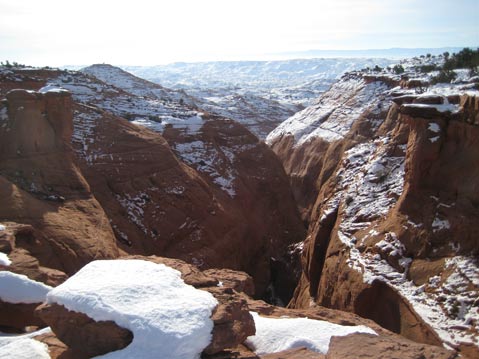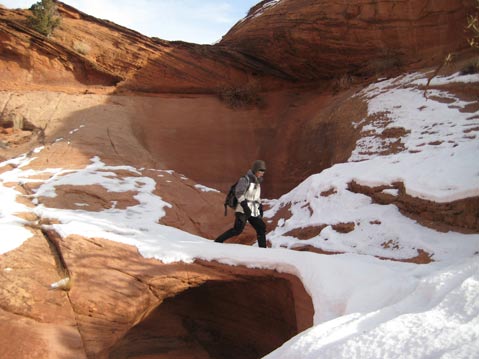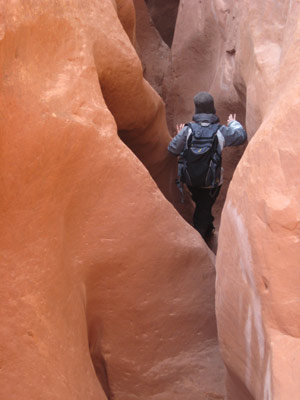Close Escapes
Canyoneering in Utah's Escalante

I was the one who said I wanted to be in the middle of nowhere on New Year’s Eve, I reminded myself as I zipped up my windproof jacket-layer number seven and I was still shivering. Our tent was pitched on a field of snow three feet deep, and Travis’s Subaru Outback, splattered with red mud from the drive in, was parked a few yards away.
We’d come to explore the canyons of Escalante, Utah’s Grand Staircase National Monument, and an unusually cold, wet winter had left the region’s vermilion cliffs and valleys dusted with white. It had also left us the place to ourselves.
A two-day drive from the Central Coast of California, Escalante is located 200 miles northeast of St. George, between Capitol Reef and Zion National parks. The entire region is characterized by dramatic geological formations, from the unlikely rock bridges of Arches National Park to the grandeur of the Grand Canyon. Some are better known and more touristed than others, and Escalante, at least in late December, fit my wish for a peaceful wilderness getaway.

We could have opted for a motel room in the small town of Escalante itself, but we were roughing it, stomping our feet and shaking our hands to improve circulation as we waited for our camp stove to heat our soup. We’d forgotten the Champagne for ringing in 2009, so instead we took a bottle of beer to bed with us. It was too cold to drink, and we were asleep before midnight.
I woke early and sat up in my sleeping bag, my head dislodging a dusting of snow from the inside of the tent roof; our breath had condensed and frozen overnight. It was time to embark on our first adventure of the New Year: a hike down one of Escalante’s narrow canyons. The hike we’d chosen was named “The Slot” for a section where the space between the canyon walls narrowed to eight inches. “This slot is not appropriate for claustrophobes,” our guidebook warned us, adding, “Overweight hikers cannot squeeze through it.” Given an indulgent few weeks of feasting over Christmas and my seven layers of clothes, I was beginning to wonder whether this was such a good idea, but we had already set off with our packs, tromping over a snow-covered wash and skirting down sections of steep slickrock to enter the mouth of the canyon.

We stopped to consult the guidebook, and I was dismayed at the author’s reference to Dante’s Inferno: Lasciate ogni speranza, voi ch’entrate (Abandon all hope, ye who enter). A New Year’s resolution sprang to mind-make it out of here alive-but I willed myself to laugh it off. It was just a simple day hike.
As we continued down the canyon, the smooth sandstone walls took on the undulating shape of water-sculpted rock, and as we rounded a bend, we came upon the first “pothole,” a bowl carved down into the rock, about six feet deep, with slick sides. “I’ll be able to get you out,” Travis quipped, so down I went, using my arms and legs to slow my descent. Sure enough, with a generous hoist from behind, I made it onto the lip-only to encounter another pothole.
So we continued, sliding down steep sections, stopping to admire the way ice formed in the lowest spots, the way the canyon’s red walls caught and refracted the diffuse winter light. At first, we hardly noticed the walls drawing closer together, until our packs began to scrape against the rock, and then I realized I was stuck. Giggling, I backed up until my pack dislodged, and tried again. This time I pushed forward until my shoulders were wedged between the walls. This was not working.
It was time to remove our packs, which we did, turning sideways and shuffling down the canyon, our noses inches from the walls, which had grown taller until only a ribbon of sky was visible, 50 feet above our heads. It occurred to me that despite the narrow space, this was a strangely exposed position. This was exactly where the hostile natives would ambush the cowboys in a bad Western; there was nowhere to hide. I resolved, once again, not to let my imagination run away with me.

Eventually, I decided to abandon my pack rather than dragging it along with one hand as it banged against my calves. Travis did the same, but a few yards farther along I could hear him behind me, breathing strangely. I turned to see that he had taken off his jacket and was perched on a ledge about a foot above the canyon floor, arms stretched above his head, eyes closed. Every time he inhaled, his chest expanded, pinning him to the walls like a book wedged too tightly on a bookshelf. When he exhaled, he was able to slide forward a few feet before the need to breathe forced him to stop. We had hit the eight-inch squeeze, and were testing out the guidebook’s warnings.
I had been feeling fine up until that moment, but something about watching my companion struggle down that restricted passageway made my heart begin to pound in my ears, and I felt my fingertips begin to tingle. I forced myself to look upward, past the high, vertical walls to that strip of sky, and to breathe. Around the next corner, the walls relented slightly, and I slumped against one of them with my eyes squeezed shut, waiting for Travis. He appeared a moment later, cheerful as ever. “I’m considering turning around,” I told him. “That was a little intense.” “Let’s keep going,” he said. “I think that was the worst of it.”
As it turned out, he was right, and though I balked a little at entering the same tight spot on the way back up the canyon, the knowledge that I’d made it through the first time helped. We emerged from the canyon’s mouth just as the setting sun cast an amber glow across the smooth, swollen expanses of slickrock. As we made our way back across the wash, following the footprints we’d left in the snow that morning, a low moan made us stop and stand silent, listening. We hadn’t seen another living creature for more than 24 hours, and our senses were heightened in the lowering light. It came again, an obvious moo this time, and we crested the last hill to find the Subaru and the tent surrounded by a herd of cattle, grazing on what they could find beneath the snow. As we approached, they ambled off, leaving their unmistakable traces behind them. I took it as our cue to move along.
We spent that night in a motel near Zion, where we toasted the first day of 2009-and our survival of “The Slot”-with a bottle of snow-chilled beer.



